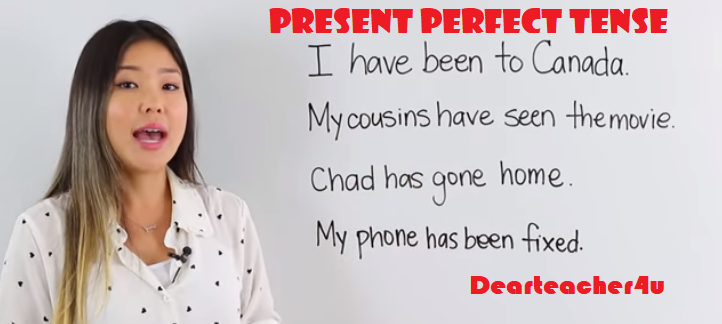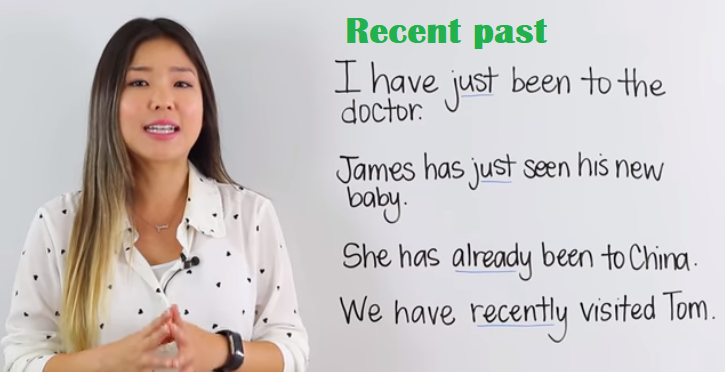Present Perfect Tense is the verb form that refers to a completed action, which is formed in English by preceding the 3rd form of the main verb with "have or has".
The word "perfect" is the main factor in this tense. In English Language, the word "perfect" comes from the Latin word "perfectus," which means complete. It always refers to the completeness of an action before the time it is under consideration.
USAGES
The present perfect tense is used with the word "just" to express a recently completed action.
Example:
He has just finished his homework.
In the above example, we refer to the action that has been done in the recent past. It means that he finished his homework just a few minutes ago. So we use the present perfect tense with the word "just" to talk about the recent past. We also use the present perfect tense with other words like "already, yet, still, etc".
The present perfect tense expresses an action that is done in the past, completed in the past, but the time is not known.
Example:
She has read "Jane Eyre".
In the above example, we don't know when she read the novel "Jane Eyre" because the time is not shown. She may have read the book a year ago or only yesterday.
The present perfect tense is used to show an action that was completed sometime in the past and may occur again in the future.
Example:
She has visited Murree.
She may revisit Murree as she is alive and can go. It means an action that we have done again and again in the past, and there is still a chance that we may do it again in the future, like she visited Murree in 2000, then in 2005, in 2018, and she might visit it again in a couple of years. So, for such actions, we use the present perfect tense.
The present perfect tense is used to show an action occurring in an incomplete period.
Example:
We can use this tense with morning, which is up to one O'clock, and after that, morning finishes and noon begins.
At 10:00 a.m., we will say:
She has taken three cups of tea this morning.
We know that at 10:00, the morning is an incomplete period. It is still morning at that time and will be completed at one O'clock.
But at 2:00 O'clock, we will say:
She took three cups of tea this morning.
Since the period is complete and has now become past, we must use the simple past tense instead of the present perfect tense.
The present perfect tense can be used for habitual action.
Examples:
She has always rejected my invitation.
I have never been late for the office.
They have always disturbed me during my exams.
The present perfect tense is used to show an action that lasts throughout an incomplete period.
Example:
Sam has been in the army for two years.
It indicates that the period is incomplete, and he is still in the army.
The present perfect tense is used to express an action that finishes at the time of speaking.
Examples:
Shahid suddenly meets Ahmad and says, I have not seen you for ages.
The guest room has not been cleaned for months (but she is cleaning it now).
The present perfect tense is used to express an action that is still continuing.
Example:
She has worked in this office for ten years (she is still working).
The present perfect tense is frequently used in newspapers and broadcasts to introduce an action that subsequently describes the simple past.
Example:
The world-renowned politician has been kidnapped. The kidnappers broke into his house.
STRUCTURE
Positive or Affirmative Sentence
She has written a letter.
Formula:
Subject + has/have + 3rd form of main verb + Object.
The formula is very simple. The subject is always followed by the auxiliary verb has/have and after the auxiliary verb, we put the 3rd form of the main or lexical verb, and then the object.
Negative Sentence
She has not written a letter.
Formula:
Subject + has/have + not + 3rd form of main verb + Object.
To make a negative sentence in the present perfect tense, we put "not" after the auxiliary verb has/have. The rest of the formula is the same as that of an affirmative sentence.
Interrogative Sentence
Has she written a letter?
Formula:
Has/have + Subject + 3rd form of the main verb + Object.
We bring the auxiliary verb before the subject to make the interrogative sentence, and after the subject, the 3rd form of the main verb is used, and then the object.
Negative Interrogative Sentence
Hasn't she written a letter?
Has she not written a letter?
Formula:
Hasn't / haven't + Subject + 3rd form of the main verb + Object
Has / have + Subject + not + 3rd form of the main verb + Object
Negative interrogative sentences can be formed in two ways. When the word "not" is contracted with the auxiliary verb, it comes before the subject; if it is not contracted, "not" follows the subject to create a negative interrogative sentence. In the first example, "not" is contracted with the auxiliary verb, while in the second example, it is in expanded form, which is why it appears after the subject.
Has or Have?
RECOGNITION IN URDU
Examples:
Recognition in Urdu is very important. It helps a lot in translation. If you don't know the tense of a sentence, you will be unable to translate it.





